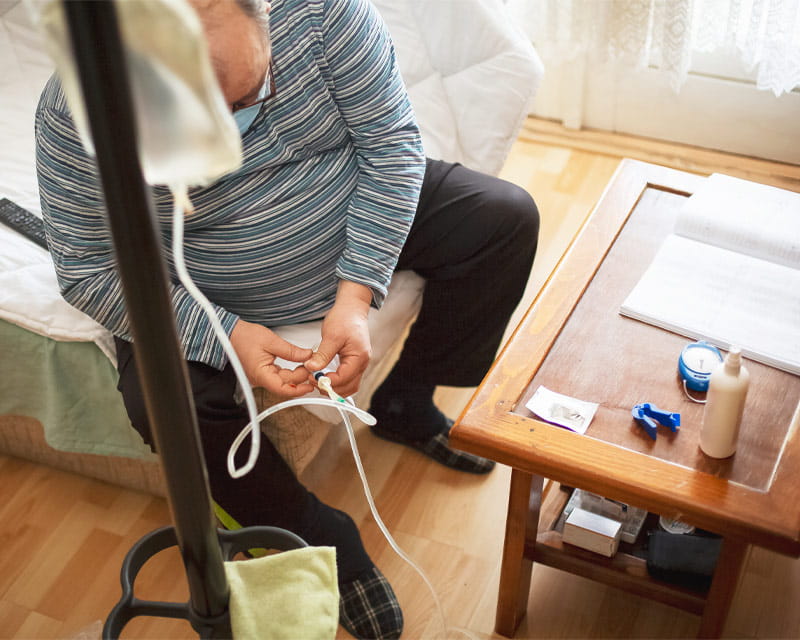
Use of hepatitis C-positive kidneys becomes standard of care for Ohio State Wexner Medical Center Transplant Program
 The COVID-19 pandemic has health care consumers looking for ways to maintain treatments with less frequent visits to clinics and hospitals. But long before COVID-19, The Ohio State University Wexner Medical Center began work to make this a reality for many people with end-stage renal disease (ESRD).
The COVID-19 pandemic has health care consumers looking for ways to maintain treatments with less frequent visits to clinics and hospitals. But long before COVID-19, The Ohio State University Wexner Medical Center began work to make this a reality for many people with end-stage renal disease (ESRD).
Dan Spetie, MD, and Khaled Boubes, MD, nephrologists at the Ohio State Wexner Medical Center, are focused on increasing the use of home dialysis for ESRD patients across central Ohio.
Since 2017, the team at the Ohio State Wexner Medical Center has doubled the number of patients receiving peritoneal dialysis (PD) at home, and they continue to grow home hemodialysis numbers as well.
“Our goal is ultimately a reflection of what is best for the patient,” Dr. Spetie says. “And what we’ve heard from patients is that they have an interest in doing dialysis at home, if possible.”
The work at the Ohio State Wexner Medical Center aligns with a national evolution in kidney care — one that will see more changes in 2021 with the launch of the Centers for Medicare & Medicaid Services (CMS) End-Stage Renal Disease (ESRD) Treatment Choices (ETC) model.
The ETC model, which will be deployed by about a third of the nation’s kidney care providers, promotes increased use of in-home dialysis treatment options.
Finding better ways to manage care for ESRD has long been a goal of CMS, in part because of the financial burden of caring for this population. While the total number of people with ESRD makes up less than 1% of all Medicare beneficiaries, the cost of care accounts for more than 7% of Medicare expenditures.
But it’s not all about finances.
“There are many benefits to in-home dialysis treatments,” Dr. Boubes says. “Whether they choose PD or home hemodialysis, patients take on more control of their care, experience fewer ‘swings’ and generally adhere better to diet and medications. Home dialysis can significantly improve quality of life.”
There are also data to support the use of PD, specifically.
“Some data shows improved mortality rates within one to two years for patients doing PD compared to traditional hemodialysis,” Dr. Spetie says. “This is significant as it increases the chances a patient will go on to a kidney transplant, which is ultimately the best possible outcome.”
The transition from in-clinic dialysis to a home-based modality can be intimidating. To support patients and empower them to move to PD or home hemodialysis, the Ohio State Wexner Medical Center worked with dialysis provider Fresenius Kidney Care to establish a Transitional Care Unit (TCU) — a concept Fresenius developed.
Udayan Bhatt, MD, nephrologist with the Ohio State Wexner Medical Center, sees patients at the TCU.
Dr. Spetie, who directs outpatient dialysis at the Ohio State Wexner Medical Center, says the TCU has been critical to their program’s successful expansion of home dialysis in Ohio.
The TCU provides one-on-one assistance to patients who may be good candidates for in-home dialysis. TCU staff answer questions and concerns and help patients develop the skills they’ll need to transition from the clinic to home.
“First and foremost, we’re focused on delivering patient-centered care,” Dr. Spetie says. “The TCU helps us to make all dialysis options available to our patients so that they can choose what’s best for them.”
Dr. Spetie and Dr. Boubes see their work as beneficial not only to patients but also to the next generation of nephrology providers — and the institutions where they’ll provide care.
“Most centers are trying to expand home therapy programs,” Dr. Boubes says. “Because we are a training center with a focus on growing home dialysis, our trainees gain experience in caring for patients who use these therapies.
“This exposure gives our trainees the knowledge and confidence they need to expand or establish home-based kidney care programs in the communities where they go on to practice.”